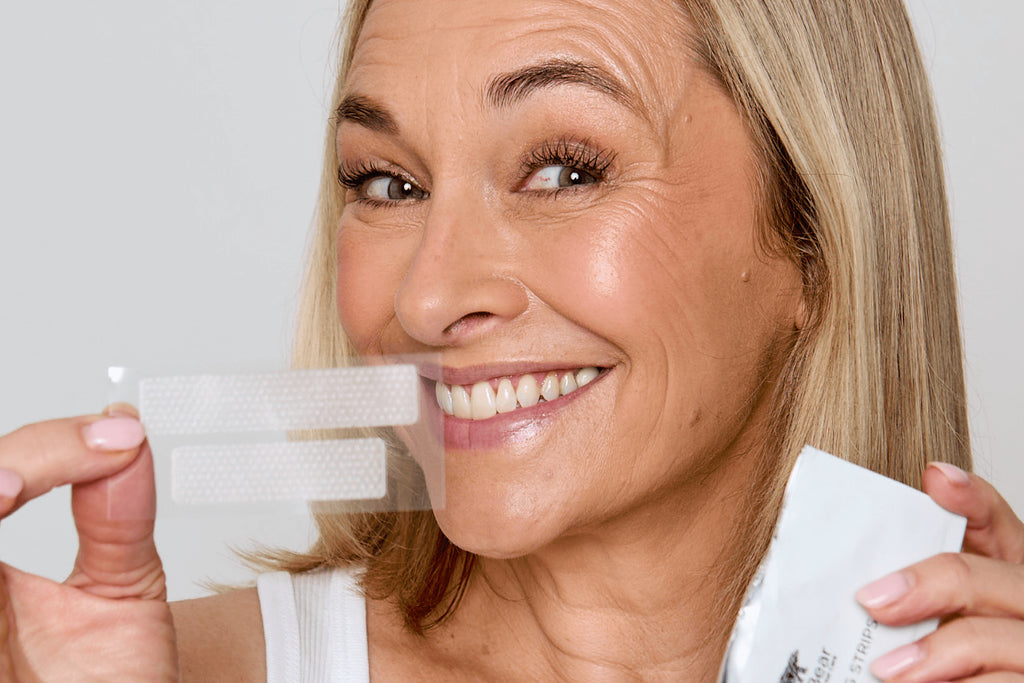Teeth Whitening Strips vs. Other Whitening Methods: Which Is Best?

We all want a confident smile, but with so many dental whitening products available, it can be tricky to know which one is right for you. Teeth whitening strips have gained massive popularity for their ease of use and visible results. But how do they compare to other methods like professional treatments or whitening toothpaste? Let’s dive into the whitening process and explore which option will help you achieve pearly whites and a radiant smile.
What Are Teeth Whitening Strips?
Teeth whitening strips are thin, flexible strips coated with a gel containing active ingredients like PAP (Phthalimidoperoxycaproic Acid). Unlike peroxide-based solutions, PAP is a safer, peroxide-free alternative that whitens teeth without causing sensitivity. These strips work by breaking down deeper stains on the tooth surface, making your teeth appear several shades whiter over a short period of time. Designed for easy, at-home use, they are a convenient addition to your oral care routine.
How Do Teeth Whitening Strips Work?
The whitening process involves the active ingredients in the strips penetrating the tooth enamel to target extrinsic stains caused by food, drinks, and lifestyle habits. PAP is an effective formula that breaks down stains without causing any damage to your enamel, making it a gentler solution compared to traditional peroxide-based products. With daily treatments over 14 consecutive days, users often notice their teeth becoming visibly brighter. For stubborn or deeper stains, advanced whitening strips can deliver more noticeable results without needing a dentist appointment.
Benefits of Teeth Whitening Strips
- Convenient and affordable – Whitening strips are an easy way to fit effective whitening into your busy schedule without breaking the bank.
- Gentle on enamel – PAP-based strips are designed to avoid damage to teeth, making them safe for regular use.
- Improves gum health – Keeping your oral care routine consistent while whitening your teeth supports overall gum health.
- Achieve pearly whites – Regular use of whitening strips helps you maintain a confident, brilliant smile.
Other Whitening Methods to Consider
Before choosing whitening strips, it’s worth knowing what other whitening options are out there. Here’s a quick look at some common dental whitening products:
Professional Whitening Treatments
These are performed by dental professionals at clinics and provide immediate results. However, they can cause tooth sensitivity and are more expensive than home treatments. Professional whitening may be suitable for those seeking a quick transformation, but effective at-home solutions are often enough.
Whitening Toothpaste
Whitening toothpaste works to remove surface stains but won’t address deeper stains. It’s a good option for maintenance but won’t deliver the same level of brightness as whitening strips. If you want to maintain your pearly whites after a whitening treatment, whitening toothpaste is a great addition to your oral care routine.
Whitening Pens
Whitening pens are quick fixes for daily touch-ups but won’t provide the level of whitening you can achieve with advanced whitening strips. They’re best used as a complement to more intensive treatments.
Teeth Whitening Strips: Safe for Everyone?
Whitening strips are generally considered safe, but there are some health issues to keep in mind. Pregnant women and individuals with existing oral care issues, like gum disease or cavities, should consult a health expert before starting a whitening process. Additionally, some people may experience temporary tooth sensitivity during or after treatment. If this happens, it’s best to reduce the frequency of use or switch to strips designed for sensitive teeth. Always seek advice from dental professionals if you’re unsure about the right whitening option for you.
How Long Do Whitening Strips Take to Work?
Most whitening strips need to be used once daily for 14 consecutive days to achieve the best results. Icy Bear advanced whitening strips are designed to help your teeth appear several shades whiter within this timeframe. The results can last several months, especially if you maintain a good oral care routine. For those with stubborn stains or who frequently consume staining foods and drinks, touch-up treatments can help maintain your radiant smile over time.
Top Tips for Using Whitening Strips Safely
1. Brush before applying – Clean teeth help the strips adhere better to the tooth surface. Ensure you don’t brush too hard right before applying, as this can cause sensitivity.
2. Follow the instructions – Overuse can damage teeth or cause unnecessary tooth sensitivity.
3. Avoid food and drinks during use – Especially coffee, tea, or wine, which can stain teeth.
4. Rinse your mouth after use – Keeping your oral care routine fresh is key to maintaining healthy teeth.
Why Whitening Strips Are a Popular Choice
Teeth whitening strips offer a balance between cost, convenience, and results. Unlike professional treatments that can cost hundreds, whitening strips are affordable and can be used at home. Plus, they’re designed to target both surface and deeper stains without damaging your tooth enamel. If you’re looking for an effective whitening solution that fits into your daily routine, strips are the way to go. Whether you’re maintaining your pearly whites or tackling stubborn stains, whitening strips provide a level of deep cleaning formula that many users love.
A Friendly Recommendation for a Brilliant Smile
Ready to start your whitening journey? Try Icy Bear’s Teeth Whitening Strips! These advanced whitening strips are formulated with PAP to minimise tooth sensitivity while delivering visible results. Perfect for achieving a brilliant smile without damaging your tooth enamel — all from the comfort of home. Add them to your oral care routine and enjoy a confident smile that turns heads. If you’re looking for a solution that’s level with expert advice, Icy Bear has you covered.
FAQs
1. Can I use whitening strips if I have sensitive teeth?
Yes! Icy Bear Whitening Strips are specifically formulated for sensitive teeth, using PAP (Phthalimidoperoxycaproic Acid), which is gentler on enamel than traditional peroxide. Many whitening strips are designed with sensitive teeth in mind, using lower peroxide levels to reduce the risk of irritation. If you experience any sensitivity during the whitening process, consider spacing out treatments or choosing a gentler formula. Tooth sensitivity typically goes away within a few days, but if it persists, it’s best to consult a dentist for advice.
2. How often should I use teeth whitening strips?
Most whitening strips are designed for daily treatments over a period of 14 consecutive days. For deeper stains or more stubborn stains, you may want to repeat the whitening process every few months. However, it’s important to follow the instructions on the packaging, as overuse can damage your teeth or cause irritation. Stick to the recommended usage for optimal results and to maintain a healthier, whiter smile.
3. Are teeth whitening strips safe for pregnant women?
Pregnant women should always consult a healthcare professional before using any whitening products, even if the formulation is peroxide-free. While Icy Bear’s peroxide-free formula with PAP is a gentler option, it’s still best to consult with your dentist during pregnancy. Your dentist can recommend alternative ways to maintain oral health and keep your teeth several shades whiter safely.
4. Can I drink coffee or tea while using whitening strips?
It’s best to avoid coffee, tea, wine, and other staining drinks during and after the whitening process. These beverages can stain your teeth and reduce the effectiveness of the whitening strips. If you can’t skip your morning coffee, consider using a straw to minimise contact with your teeth. Additionally, rinsing your mouth with water after consuming stain-causing drinks will help maintain your brilliant smile and prevent new stains from setting in.
5. How long do results from whitening strips last?
The results from teeth whitening strips can last anywhere from a few months to a year, depending on your oral care routine. To prolong your radiant smile, avoid stain-causing foods and drinks, and use a whitening toothpaste for maintenance. If you notice stains returning, you can do touch-up treatments to keep your smile looking healthy and bright. Regular use of the whitening strips will help maintain the best results over time.




